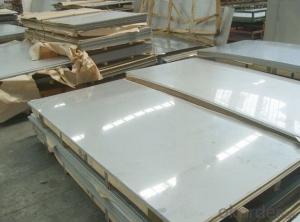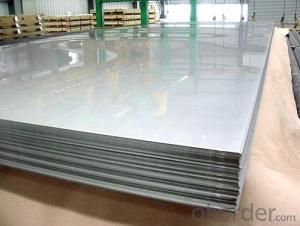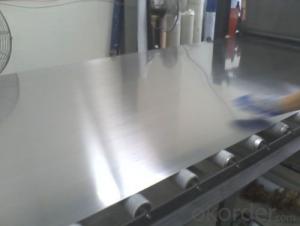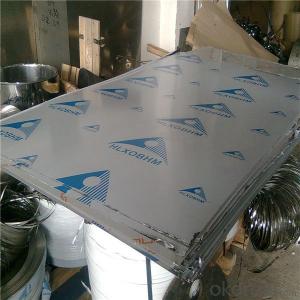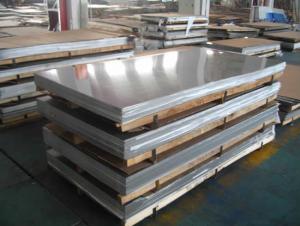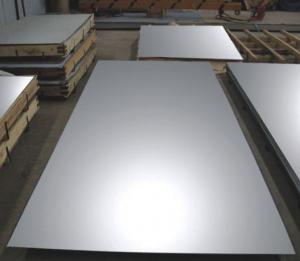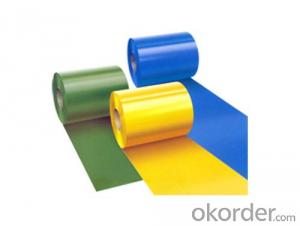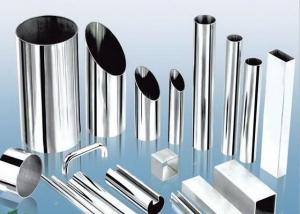steel plate of Stainless
- Loading Port:
- China Main Port
- Payment Terms:
- TT OR LC
- Min Order Qty:
- -
- Supply Capability:
- -
OKorder Service Pledge
OKorder Financial Service
You Might Also Like
According to the method of cold and hot points two kinds, including 0.5 4 mm thickness of plates and 4.5-35 mm thick plate.
According to the characteristics of the steel group is divided into five categories: austenitic size, austenitic grain size, iron-iron grain size, shape, markov precipitation sclerosis type.
Requests can withstand oxalic acid, sulfuric acid, nitric acid, nitric acid-ferric sulfate-hydrofluoric acid, sulfuric acid, phosphoric acid, formic acid, copper sulfate, acetic acid, etc. Various kinds of acid corrosion, widely used in chemical industry, food, medicine, paper making, oil, atomic energy industry etc, as well as the construction, kitchen utensils, tableware, vehicles of all kinds of parts, household appliances.
In order to ensure that each kind of stainless steel plate of the yield strength, tensile strength, elongation and hardness of mechanics performance accords with a requirement, steel plate must pass before delivery annealing, solid solution treatment, aging treatment of heat treatment, etc.
Stainless steel plate [1] the surface is bright and clean, have a high plasticity and toughness and mechanical strength, acid and alkaline gas and other media, the solution of the corrosion. It is not an easy to rust of alloy, but not absolutely doesn't rust.
Stainless steel corrosion depends primarily on its alloy composition (chrome, nickel, titanium, silicon, aluminum, etc) and internal organizational structure, plays a main role is chrome elements. Chrome has the very high chemical stability, can in the steel surface passivation membrane formation, the metal and isolated, protect steel plate were not oxidation, enhance the steel corrosion resistance. Passivation membrane destruction, the corrosion resistance will decline.
- Q: Can stainless steel sheets be used for elevator mirrors?
- Certainly! Elevator mirrors can indeed be made using stainless steel sheets. Stainless steel, being both durable and versatile, is a favored material for elevator interiors due to its sleek and polished look. By polishing stainless steel sheets to a mirror-like finish, they can be effectively utilized as reflective surfaces for elevator mirrors. Furthermore, stainless steel's resistance to corrosion makes it well-suited for the humid and frequently challenging conditions typically encountered in elevators.
- Q: What is the composition of stainless steel sheets?
- Stainless steel sheets are primarily composed of iron, chromium, and nickel, with varying levels of carbon and other elements depending on the specific grade or alloy.
- Q: What are stainless steel sheets used for?
- Stainless steel sheets are used for a variety of applications across various industries. Due to their excellent corrosion resistance, durability, and aesthetic appeal, these sheets are widely utilized in both commercial and residential settings. In the construction industry, stainless steel sheets are used for roofing, cladding, and facades, as they can withstand harsh environmental conditions and provide a modern, sleek appearance. In the automotive industry, they are commonly used for manufacturing car bodies, exhaust systems, and decorative trims. Moreover, stainless steel sheets find extensive use in the food and beverage industry, where their hygienic properties make them suitable for kitchen equipment, countertops, and food processing machinery. Additionally, these sheets are employed in medical equipment, pharmaceuticals, and laboratory settings due to their resistance to corrosion and easy cleanability. Other applications include furniture, appliances, signage, and decorative purposes, as stainless steel sheets can be easily customized and formed into various shapes and sizes. Overall, stainless steel sheets are a versatile material that meets a wide range of needs across different industries, thanks to their durability, strength, and corrosion resistance properties.
- Q: How do I calculate the strength of stainless steel sheets?
- To calculate the strength of stainless steel sheets, you need to consider factors such as the material's tensile strength, yield strength, and thickness. Tensile strength refers to the maximum amount of stress a material can withstand before it breaks, while yield strength is the maximum stress the material can endure without permanent deformation. Additionally, the thickness of the sheet will also affect its overall strength. By referring to the specifications provided by the manufacturer or consulting relevant engineering resources, you can determine the specific strength values for the stainless steel sheets you are working with.
- Q: What is the maximum temperature stainless steel sheets can withstand?
- The maximum temperature stainless steel sheets can withstand depends on the specific grade of stainless steel. Generally, most stainless steel grades can withstand temperatures up to around 1500°F (815°C) before experiencing significant oxidation or scaling. However, certain high-temperature grades of stainless steel, such as 310 or 321, can withstand temperatures up to 2100°F (1150°C) or even higher. It is important to consider the specific application and grade of stainless steel when determining the maximum temperature it can withstand to ensure optimal performance and durability.
- Q: 304 stainless steel plate surface quality inspection method which has several?
- If uneven surface oxide thickness of stainless steel plate, the surface of base metal thick smooth places and thin places following different degrees of surface and acid dissolved and oxidized surface oxide skin skin attachment site base metal by the acid erosion degree is different, so the steel plate surface is not uniform. Therefore, when the heat treatment is heated, the oxide scale must be uniformly formed. To achieve this, we must pay attention to the following problems: stainless steel plate in the heating oil if the workpiece surface, oil adhesion of oxide thickness parts and other parts of the oxide thickness and composition is different, and will produce carburizing.
- Q: What are the benefits of using embossed stainless steel sheets in elevator interiors?
- There are several benefits of using embossed stainless steel sheets in elevator interiors. Firstly, embossed stainless steel sheets add a touch of elegance and sophistication to the overall design of the elevator. The embossed patterns create a visually appealing surface that can enhance the aesthetic appeal of the interior space. This is especially important in commercial buildings and high-end residential complexes where a luxurious ambiance is desired. Secondly, embossed stainless steel sheets are highly durable and resistant to wear and tear. Elevator interiors are subject to constant use and can be prone to scratches, dents, and other damages. The embossed pattern on the stainless steel surface helps to hide minor imperfections, ensuring that the interior maintains its pristine appearance for a longer period of time. Additionally, stainless steel is known for its corrosion resistance, making it a suitable choice for environments with high humidity levels, such as elevator shafts. Furthermore, embossed stainless steel sheets are easy to clean and maintain. Elevator interiors are often exposed to dirt, fingerprints, and other stains. The smooth surface of the embossed stainless steel makes it easy to wipe away these marks, ensuring that the interior always looks clean and well-maintained. This is particularly important in public spaces where cleanliness is essential for creating a positive impression on users. Additionally, embossed stainless steel sheets offer a high level of customization. They can be manufactured in various patterns, textures, and finishes, allowing for endless design possibilities. This enables architects and designers to create unique and personalized elevator interiors that reflect the desired theme or branding of a building. The versatility of embossed stainless steel also makes it easy to match with other interior design elements, such as flooring, lighting fixtures, and wall coverings. In conclusion, the benefits of using embossed stainless steel sheets in elevator interiors include enhanced visual appeal, durability, ease of maintenance, and customization options. These qualities make embossed stainless steel an ideal material for elevators in various settings, from commercial buildings to residential complexes, adding value and elegance to the overall design.
- Q: Can stainless steel sheets be used for electromagnetic compatibility?
- Yes, stainless steel sheets can be used for electromagnetic compatibility. Stainless steel has excellent electrical conductivity and high magnetic permeability, which helps in shielding electromagnetic interference (EMI) and radio frequency interference (RFI). It is commonly used in applications where electromagnetic compatibility is required, such as enclosures, cabinets, and shielding components in electronic devices.
- Q: Are stainless steel sheets suitable for high-temperature applications?
- Yes, stainless steel sheets are suitable for high-temperature applications. Stainless steel is known for its excellent heat resistance properties, making it an ideal material for use in high-temperature environments. It can withstand extreme heat without losing its strength or structural integrity, making it highly durable and reliable. Stainless steel sheets are often used in industries such as aerospace, automotive, and manufacturing, where high temperatures are common. Additionally, stainless steel sheets have low thermal expansion, which means they can maintain their shape and dimensions even when exposed to fluctuating temperatures. This makes stainless steel sheets a preferred choice for applications where dimensional stability is crucial. Overall, stainless steel sheets are a suitable option for high-temperature applications due to their exceptional heat resistance, durability, and dimensional stability.
- Q: What are the different types of edge profiles for stainless steel sheets?
- There are several different types of edge profiles that can be applied to stainless steel sheets, depending on the desired aesthetic and functional requirements. Some of these edge profiles include: 1. Square Edge: This is the most basic and common edge profile for stainless steel sheets. It features a straight, square edge without any additional shaping or finishing. 2. Beveled Edge: A beveled edge is achieved by cutting and shaping the edge of the stainless steel sheet at an angle. This profile adds a slight slope or chamfer to the edge, giving it a more refined and polished appearance. 3. Rounded Edge: Also known as a bullnose edge, this profile involves rounding off the sharp edges of the stainless steel sheet. It creates a smooth and curved edge that minimizes the risk of injuries from sharp corners. 4. Full Radius Edge: This edge profile involves creating a complete semicircular or rounded edge along the length of the stainless steel sheet. It offers a more pronounced curved appearance compared to a rounded edge. 5. Ogee Edge: An ogee edge profile features a double curve, with one concave curve followed by a convex curve. It adds an elegant and decorative touch to the stainless steel sheet, making it suitable for applications that require a more ornamental look. 6. Dupont Edge: This edge profile is characterized by a straight edge with a small bevel on the top and bottom sides of the sheet. It offers a sleek and modern appearance, often used in contemporary design applications. 7. Knife Edge: A knife edge profile involves sharpening the edge of the stainless steel sheet to create a thin, sharp edge. This profile is commonly used for applications where a precise and clean-cut appearance is desired. These are just a few examples of the different edge profiles available for stainless steel sheets. The choice of edge profile depends on the intended use, style preferences, and specific requirements of the project at hand.
Send your message to us
steel plate of Stainless
- Loading Port:
- China Main Port
- Payment Terms:
- TT OR LC
- Min Order Qty:
- -
- Supply Capability:
- -
OKorder Service Pledge
OKorder Financial Service
Similar products
Hot products
Hot Searches
Related keywords
